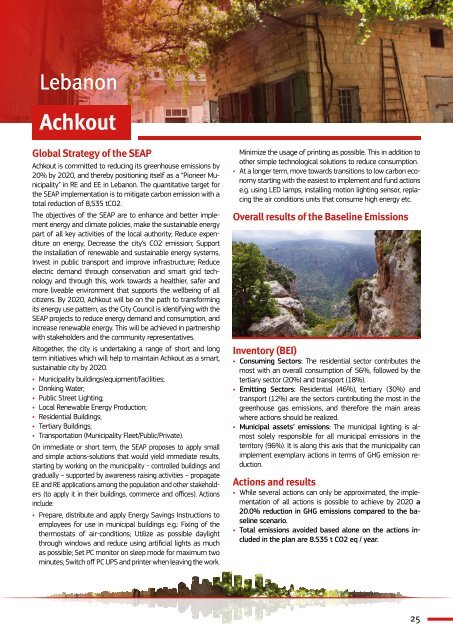CES-MED Publication EN-final 2018-WEB
You also want an ePaper? Increase the reach of your titles
YUMPU automatically turns print PDFs into web optimized ePapers that Google loves.
Lebanon<br />
Achkout<br />
Global Strategy of the SEAP<br />
Achkout is committed to reducing its greenhouse emissions by<br />
20% by 2020, and thereby positioning itself as a “Pioneer Municipality”<br />
in RE and EE in Lebanon. The quantitative target for<br />
the SEAP implementation is to mitigate carbon emission with a<br />
total reduction of 8,535 tCO2.<br />
The objectives of the SEAP are to enhance and better implement<br />
energy and climate policies, make the sustainable energy<br />
part of all key activities of the local authority; Reduce expenditure<br />
on energy, Decrease the city’s CO2 emission; Support<br />
the installation of renewable and sustainable energy systems,<br />
Invest in public transport and improve infrastructure; Reduce<br />
electric demand through conservation and smart grid technology<br />
and through this, work towards a healthier, safer and<br />
more liveable environment that supports the wellbeing of all<br />
citizens. By 2020, Achkout will be on the path to transforming<br />
its energy use pattern, as the City Council is identifying with the<br />
SEAP projects to reduce energy demand and consumption, and<br />
increase renewable energy. This will be achieved in partnership<br />
with stakeholders and the community representatives.<br />
Altogether, the city is undertaking a range of short and long<br />
term initiatives which will help to maintain Achkout as a smart,<br />
sustainable city by 2020.<br />
• Municipality buildings/equipment/facilities;<br />
• Drinking Water;<br />
• Public Street Lighting;<br />
• Local Renewable Energy Production;<br />
• Residential Buildings;<br />
• Tertiary Buildings;<br />
• Transportation (Municipality Fleet/Public/Private).<br />
On immediate or short term, the SEAP proposes to apply small<br />
and simple actions-solutions that would yield immediate results,<br />
starting by working on the municipality - controlled buildings and<br />
gradually – supported by awareness raising activities – propagate<br />
EE and RE applications among the population and other stakeholders<br />
(to apply it in their buildings, commerce and offices). Actions<br />
include:<br />
• Prepare, distribute and apply Energy Savings Instructions to<br />
employees for use in municipal buildings e.g.: Fixing of the<br />
thermostats of air-conditions; Utilize as possible daylight<br />
through windows and reduce using artificial lights as much<br />
as possible; Set PC monitor on sleep mode for maximum two<br />
minutes; Switch off PC UPS and printer when leaving the work.<br />
Minimize the usage of printing as possible. This in addition to<br />
other simple technological solutions to reduce consumption.<br />
• At a longer term, move towards transitions to low carbon economy<br />
starting with the easiest to implement and fund actions<br />
e.g. using LED lamps, installing motion lighting sensor, replacing<br />
the air conditions units that consume high energy etc.<br />
Overall results of the Baseline Emissions<br />
Inventory (BEI)<br />
• Consuming Sectors: The residential sector contributes the<br />
most with an overall consumption of 56%, followed by the<br />
tertiary sector (20%) and transport (18%).<br />
• Emitting Sectors: Residential (46%), tertiary (30%) and<br />
transport (12%) are the sectors contributing the most in the<br />
greenhouse gas emissions, and therefore the main areas<br />
where actions should be realized.<br />
• Municipal assets’ emissions: The municipal lighting is almost<br />
solely responsible for all municipal emissions in the<br />
territory (96%). It is along this axis that the municipality can<br />
implement exemplary actions in terms of GHG emission reduction.<br />
Actions and results<br />
• While several actions can only be approximated, the implementation<br />
of all actions is possible to achieve by 2020 a<br />
20.0% reduction in GHG emissions compared to the baseline<br />
scenario.<br />
• Total emissions avoided based alone on the actions included<br />
in the plan are 8.535 t CO2 eq / year.<br />
25
















